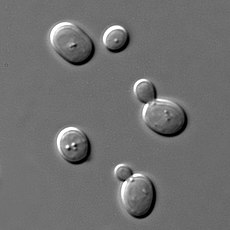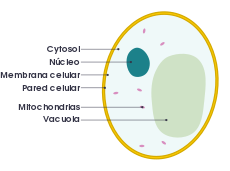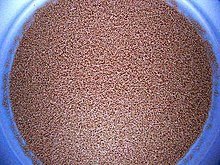Yeast
Yeast or ferment is any of the predominantly unicellular microscopic fungi in their life cycle, generally characterized by dividing asexually by budding or bipartition and by having sexual stages they are not attached to a mycelium or set of hyphae. However, some yeasts such as Candida can form chains of connected budding cells, known as pseudohyphae. With their unicellular growth habit, yeasts can be contrasted with molds that produce hyphae. There are fungi that can have both stages in their life cycle and in this case they are called dimorphic fungi.
Although in some botanical texts "true" yeasts are considered to belong only to the Ascomycota division, from a microbiological perspective all fungi with a predominance of a unicellular phase in their life cycle have been called yeast, including basidiomycete fungi. Yeasts are in Ascomycota (mainly classified in Saccharomycotina subdivision and classes Schizosaccharomycetes, Pneumocystidomycetes, Eurotiomycetes, Dothideomycetes) and Basidiomycota (classified in Cystobasidiomycetes, Microbotryomycetes, Tremellomycetes classes and Ustilaginomycotina subdivision). Also unicellular fungi can be found in the divisions Chytridiomycota and Rozellomycota.
Yeasts are important for their ability to decompose by fermentation (predominantly alcoholic) various organic compounds, mainly sugars or carbohydrates, producing different substances. One of the best known yeasts is the species: Saccharomyces cerevisiae. This yeast has the ability to grow anaerobically performing alcoholic fermentation. For this reason it is used in many industrial fermentation processes, similar to chemical yeast, for example in the production of beer, wine, mead, bread, antibiotics, etc They also produce enzymes capable of breaking down various substrates, mainly sugars, and some protein structure.
Yeast is the first eukaryotic cell in which an attempt has been made to express recombinant proteins, because it is easy to use industrially: it is cheap, it is easy to grow, and it doubles every 90 minutes under favorable nutritional conditions. In addition, it is an easy organism to genetically modify, which allows experiments to be carried out in several days or weeks. However, yeasts have a different glycosylation mechanism than that found in human cells, so the products are immunogenic.
Habitat
Yeasts are usually present in soils, rocks and aquatic environments such as rivers and seas, on plant leaves, fruits, on the skin of animals where they are also part of the microbiota, on other macroscopic fungi such as mushrooms and foods where they are used as ferment. Regarding their way of life, they can be saprotrophs or parasites of plants, animals or other fungi. Examples of pathogenic yeasts for humans are Candida, Pneumocystis, Cryptococcus , among others.
Regarding their nutrition and metabolism, yeasts are chemoorganotrophs, since they use organic compounds as an energy source and do not need sunlight to grow. They obtain carbon mainly from hexose sugars, such as glucose and fructose, or disaccharides such as sucrose and maltose. Some species can metabolize pentose sugars such as ribose, alcohols, and organic acids. Yeast species require oxygen for aerobic (obligate aerobes) or anaerobic respiration, but they also have aerobic methods of energy production (facultative anaerobes). Unlike bacteria, no known yeast species grows only anaerobically (obligate anaerobes). Most yeasts grow best in a neutral or slightly acidic pH environment. Yeasts vary in the temperature range in which they grow best. For example, Leucosporidium frigidum grows from -2 to 20 °C (28 to 68 °F), Saccharomyces telluris from 5 to 35 °C (41 to 95 °F). and Candida slooffi 28 to 45 °C (82 to 113 °F). Cells can survive freezing under certain conditions, and viability decreases over time.
Yeasts reproduce asexually by budding or budding and sexually by ascospores or basidiospores. During asexual reproduction, a new bud emerges from the mother yeast when the right conditions are met, after which the bud separates from the yeast. mother upon reaching adult size. Under nutrient-poor conditions, yeasts that are capable of sexual reproduction will form spores. Yeasts that are not capable of going through the complete sexual cycle are classified within the genus Candida.
Evolution
According to molecular and biodiverse data, yeasts evolved from multicellular ancestors, especially because they belong to the Ascomycetes and Basidiomycetes where most fungi are multicellular or dimorphic, and because in most molecular analyzes they occupy positions alongside fungi. more complex.
The ancestors of yeasts may have been molds that became multicellular due to parasitism, or dimorphic fungi that adapted to living in a predominantly unicellular state. Yeasts do not form a monophyletic group, therefore these processes occurred several times in different lineages of ascomycetes and basidiomycetes.
Genome
The so-called yeast genome is composed of approximately 12,156,677 base pairs and 6,275 genes compactly organized in 16 chromosomes ranging in size from 200 to 2200 Kb, in which as a result of the analysis a total of 6183 frames were located open reading frames (ORF) and 5800 protein-coding genes were found. The average size of yeast genes is 1.45 kb or 483 codons and only 3.8% of ORFs contain introns. Ribosomal RNA is encoded by 120 tandem repetitive sequences on the chromosome, while there are 262 genes that code for transfer RNAs, 80 of which have introns. Chromosomes contain mobile genetic elements such as plasmids (this being a special case of eukaryotes that present this element) and retrotransposons (subclass of transposons) that vary in number and position in different strains, even though most laboratory strains have approximately 30 elements.
Mitochondrial DNA can also be considered part of the yeast genome. This DNA codes for components of the translational machinery of mitochondria and approximately 15% of mitochondrial proteins. There are mutants that lack mitochondrial DNA, these are called ro and lack the polypeptides that are synthesized in mitochondrial ribosomes. These mutants are unable to carry out respiratory metabolism, but are viable and capable of fermenting substrates such as glucose. The 2μ circular plasmid is present in most yeasts, to date no function has been found for this plasmid except for its own replication and gene transfer.
Virtually all yeasts contain double-stranded RNA viruses present as endogenous viral elements that make up 0.1% of the genome and code for generating defensive toxins. In addition, the presence of other infectious agents such as prions (PrPSc proteins) have been detected, which play the role of nitrogen metabolic regulation. Yeast prions also called "fungal" they do not become pathogenic unlike mammalian prions.
It is estimated that 31% of yeast genes have homologues with those of the human genome.
Yeast fermentation process
There are 2 types of fermentation: alcoholic and lactic acid.
Alcoholic
Alcoholic fermentation is a biological fermentation process in the absence of oxygen (O2), caused by the activity of some microorganisms such as yeasts and bacteria that process sugars (carbohydrates) such as: glucose, sucrose, fructose, among others. The final products obtained from this process are: ethanol, carbon dioxide, NAD+ and 2 ATP.
Alcoholic fermentation produces very little net energy: 2 ATP for each pyruvate obtained from glycolysis. As a result, ethanol (the main product used in wine, beer and vinegar producing companies) and carbon dioxide (CO2) are also obtained.
C6H12O6 + 2 Pi + 2 ADP + 2 NAD → 2 CH3-CH2OH + 2 CO2 + 2 ATP + 2 NAD
Lactic
Lactic acid fermentation occurs in some protozoa and in animal tissues. Its main use is in obtaining cheese, yogurt, soy sauce, and other products derived from milk.
In animal tissues, lactic acid (or lactate) is produced from pyruvate. In muscle cells, when the supply and stores of oxygen (myoglobin) are depleted during strenuous physical exercise, pyruvate stops entering the mitochondria (it enters in the presence of O2 for energy) and begins lactic fermentation (anaerobic). Large amounts of lactate are responsible for fatigue and muscle pain.
- Glucolysis:
Glucose (C6H12O6+ 2 ADP + 2 Pi + 2 NAD }}}" xmlns="http://www.w3.org/1998/Math/MathML">Δ Δ {displaystyle {ce {cHFF}}}}}" aria-hidden="true" class="mwe-math-fallback-image-inline" src="https://wikimedia.org/api/rest_v1/media/math/render/svg/4ec7affe508f808c307bf7a219abfe179b143ce8" style="vertical-align: -0.338ex; width:3.806ex; height:1.843ex;"/> 2 Piruvato (C3H4O3+ 2 ATP + 2 NADH + 2 H+ + 2 H2O
- Reduction of the pyruvate to the infant:
2 Piruvato (C3H4O3) + 2 NADH + 2 H+ }}}" xmlns="http://www.w3.org/1998/Math/MathML">Δ Δ {displaystyle {ce {cHFF}}}}}" aria-hidden="true" class="mwe-math-fallback-image-inline" src="https://wikimedia.org/api/rest_v1/media/math/render/svg/4ec7affe508f808c307bf7a219abfe179b143ce8" style="vertical-align: -0.338ex; width:3.806ex; height:1.843ex;"/> 2 Lactate (C3H6O3) + 2 NAD
The fermentation of one mole of glucose generates two moles of lactic acid.
Uses
The physiological properties of yeast have led to its use in the field of biotechnology. The fermentation of sugars (carbohydrates) by yeast is the largest and oldest application of this technology. Many types of yeast are used to make many foods: baker's yeast in the production of bread, brewer's yeast in the fermentation of beer, and yeast in the fermentation of wine and for the production of xylitol. The so-called red yeast rice is actually a mold, Monascus purpureus. Yeasts include some of the most widely used model organisms for genetics and cell biology.
Types of yeast
Yeast, the most common being S. cerevisiae, is used in bakeries (to make bread, pizza dough, buns, or brioches) as a leavening agent, which converts fermentable compounds present in dough into carbon dioxide gas. This causes the mass to expand, or rise, as the gas forms bubbles, or pockets. When the dough is baked, the yeast dies and the air pockets become 'set', giving the baked good a light and fluffy texture. The use of potatoes, potato boiling water, eggs or sugar in a bread dough, accelerates the growth of yeasts. Most of the yeasts used in bakery and pastry are of the same species as those used in alcoholic fermentation. In addition, Saccharomyces exiguus (also known as S. minor), a wild yeast found on plants, fruits, and grains, is occasionally used in baking. In baking, the yeast initially respires aerobically, producing carbon dioxide and water. When the oxygen runs out, fermentation begins, producing ethanol as a waste product; however, it evaporates during baking.
It is not known when yeast was first used to make bread. However, the first record showing this use comes from Ancient Egypt. The researchers speculate about a food mix of flour and water, food that was left out longer than usual on a warm day, and yeasts that breed on natural contaminants in the flour caused it to ferment before baking. The resulting bread would have ended up being lighter and tastier than the usual hard flat cake.
Today, there are several retailers of baker's yeast; one of the best known in North America is Fleischmann's yeast, which was developed in 1868. During World War II, Fleischmann developed a dry, granulated active yeast, not requiring refrigeration, that had a longer shelf life than conventional yeast. fresh yeast (over a year old vs. a month or so) and rising twice as fast.
Baker's yeast is also sold as fresh yeast compressed into a "cake" square. This form perishes quickly, so it must be used within a short time after production. A weak solution of sugar and water can be used to determine if yeast activity has expired. In the solution, the active yeast will foam and bubble as it ferments the sugar into ethanol and carbon dioxide. Some recipes refer to this as a yeast test, as it checks the viability of the yeast before adding it to the brew. When using a sourdough starter, flour and water are added instead of sugar; this is known as a sponge test.
When yeast is used to make bread, it is mixed with flour, salt, and hot water or milk. The dough is kneaded until smooth, and then allowed to rise, sometimes until double in size. Then it is divided and shaped. Some bread doughs are kneaded again after the first rise and allowed to rise again (this is called rising), after which they are put in the oven. However, a longer rising time gives a better flavor, but the yeast can stop rising the bread in the final stages if left too long at the beginning.
Recipes for bread machines often refer to dry yeast; however, a (wet) sourdough can also work.
Contenido relacionado
Giraffa camelopardalis
Milk
Proteals






